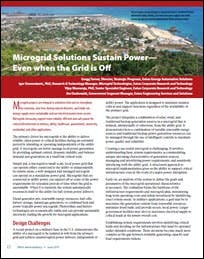The ability to island a microgrid safely is crucial to one of its essential missions — delivering reliable power to critical facilities during a power outage. This, in fact, is a primary driver for microgrids’ growing popularity among public and private institutions.
Download the full report now.
The team at Eaton is focused on leveraging the knowledge and expertise gained from the supply of numerous turnkey government and commercial microgrid installations. In keeping with this mission, Eaton has published a white paper, “Microgrid Solutions Sustain Power – Even When the Grid is Off.” The paper delves into how microgrid projects are integral to initatives that aim to “strengthen the economy, save lives during natural disasters, and make our energy supply more sustainable and our electrical power more secure.”
As small local power grids, microgrids can operate either connected to the utility or independently — islanded. This self-sufficiency makes microgrids ideal solutions for remote areas where no grid exists or where the grid is unreliable. In developed areas, like much of the United States, the microgrid’s islanding ability comes into play during storms or disasters when the central grid fails.
The team at Eaton is focused on leveraging the knowledge and expertise gained from the supply of numerous turnkey government and commercial microgrid installations.
But there are some design challenges, the team at Eaton shared, when launching a microgrid.
“It involves understanding basic system requirements, accommodating unique operating characteristics of generation sources, managing and prioritizing power requirements, and seamlessly interfacing with the utility grid,” the report states.
In short, a structured approach is needed. First things first. When implementing a microgrid, government or commercial entities need to define the goals and parameters of the microgrid, which forms the “backbone” of the infrastructure requirements and microgrid plan. When establishing system requirements, one needs to identity critical loads and decide on the infrastructure that needs to be operated under islanded conditions.
Microgrids must be proven “safe” to island while providing power to critical loads and services, such as hospitals or waste water plants.
Figure 1 demonstrates microgrid controls developed for anti-islanding capability. Frequency and voltage deviation generated by the controller allows the protection relay to open the microgrid
interconnection switch. This allows the microgrid to isolate from a faulted line and power loads
within the microgrid while safely allowing service personnel to work on the faulted line.
Diagram: courtesy of Eaton.
A variety of system design and testing considerations must be undertaken to island a microgrid safely.
“It is critical to carefully consider the hardware foundation that will form the control system and tap proven technology and products to support the system,” says the report.
Some of the elements that need to be tested include communication protocols, cybersecurity, traceability – in the case of those serving critical government facilities – and more.
[clickToTweet tweet=”When designed well, #microgrids are safe, reliable, efficient and sustainable. ” quote=”When designed well, #microgrids are safe, reliable, efficient and sustainable. “]
Ultimately, when designed well, microgrids are safe, reliable, efficient and sustainable. The team at Eaton points out that with the continuing proliferation of distributed energy sources, the grid will become a much more “dynamic electrical environment,” which will require “ever-smarter apparatus, faster communications, and automation systems in order to maintain grid stability and power quality.”
The complete white paper covers the following:
- Microgrid Design Challenges
- Islanding
- System Design and Testing Considerations
To learn more about the how to design and island a microgrid, download the full white paper for free, courtesy of Eaton.









